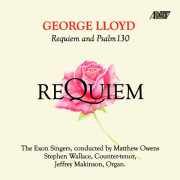

George Lloyd’s Requiem, his final work, was completed in January 1998, seven months before his death at the age of eighty-five. It is a setting of the standard Latin text with the exception of the Libera Me because, characteristically, the composer wished to finish the piece on a positive note, which he does in style with one of his most memorable “big tunes” (as he liked to call them). Suffering from heart failure, Lloyd found he did not possess the necessary strength to score his Requiem for full orchestra and so chose the smaller-scale forces of solo counter-tenor, chorus and organ. Written in memory of Diana, Princess of Wales (the occasional use of chant-like declamatory passages for the soloist recalls the ending of Verdi’s Requiem, a favourite work of Diana’s), the Requiem is also a conscious leave-taking on the part of the composer. When the “big tune” finally steals in near the end of the concluding Lux Aeternam, it is hard to remain unmoved by the typically Lloydian combination of disarming simplicity and life-affirming optimism, especially in its poignant, valedictory context. Paul Conway
He knew when he wrote it that he didn't have long to live. It was begun in autumn 1997, finished in late January 1998, and the score proofed in May; two months later he was dead. Its composer being the man he was, the musical language is immediately accessible, and unashamedly melodic - his tunes melt in your ears. The harmonic world is less individual than much of the orchestral music, but I wonder whether that wasn't part of his design - a retreat of the individual before something larger and more important. And somehow the sentiment survives the relative anonymity of the language. Lloyd does use plenty of dramatic contrast, though: his chorus exclaim as well as whisper; soloists step forward from their ranks; the style ranges from richly Romantic to false-Medieval (in the Hostias and Sanctus'); the organ subtly underpins here and thunders there. Martin Anderson